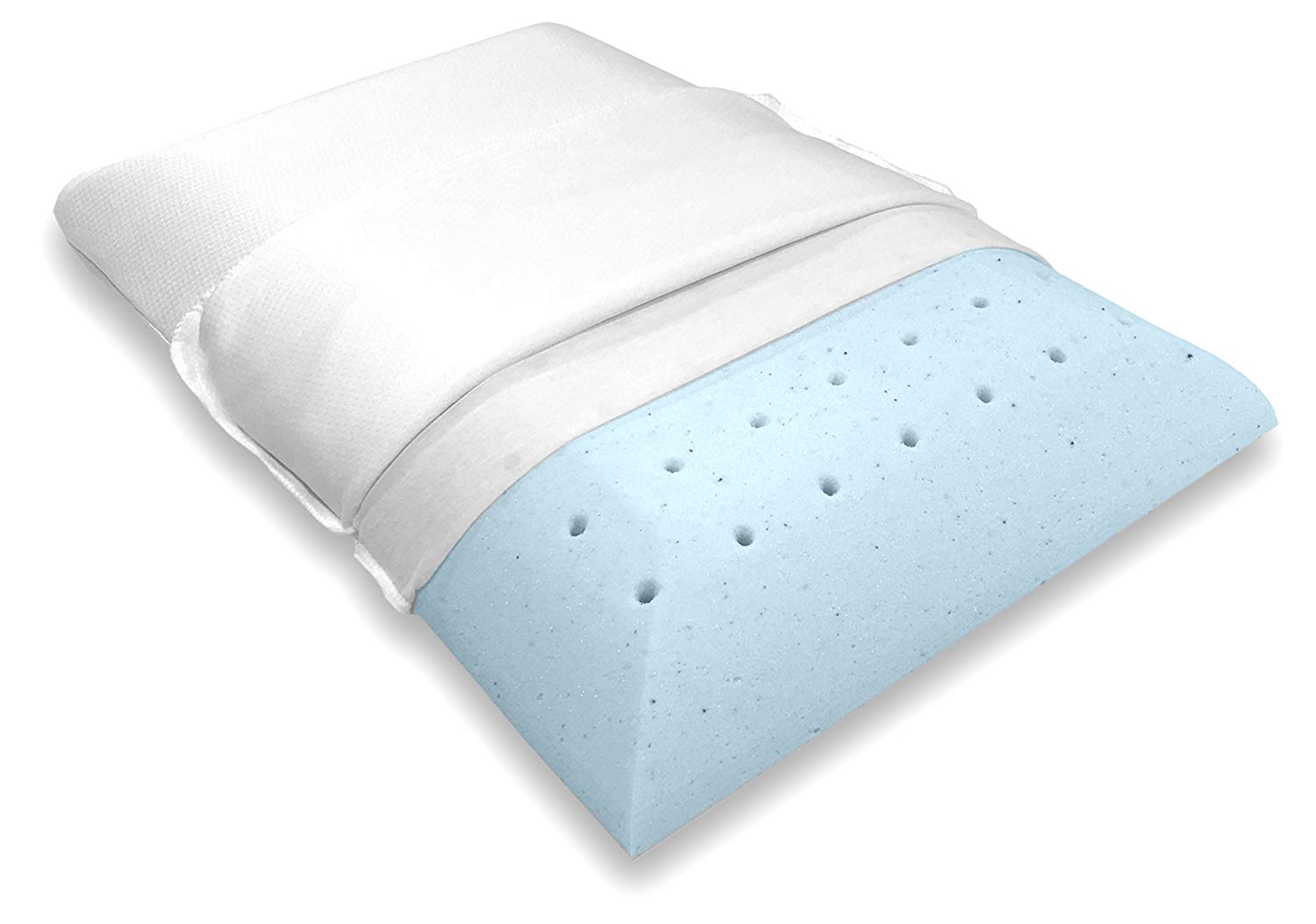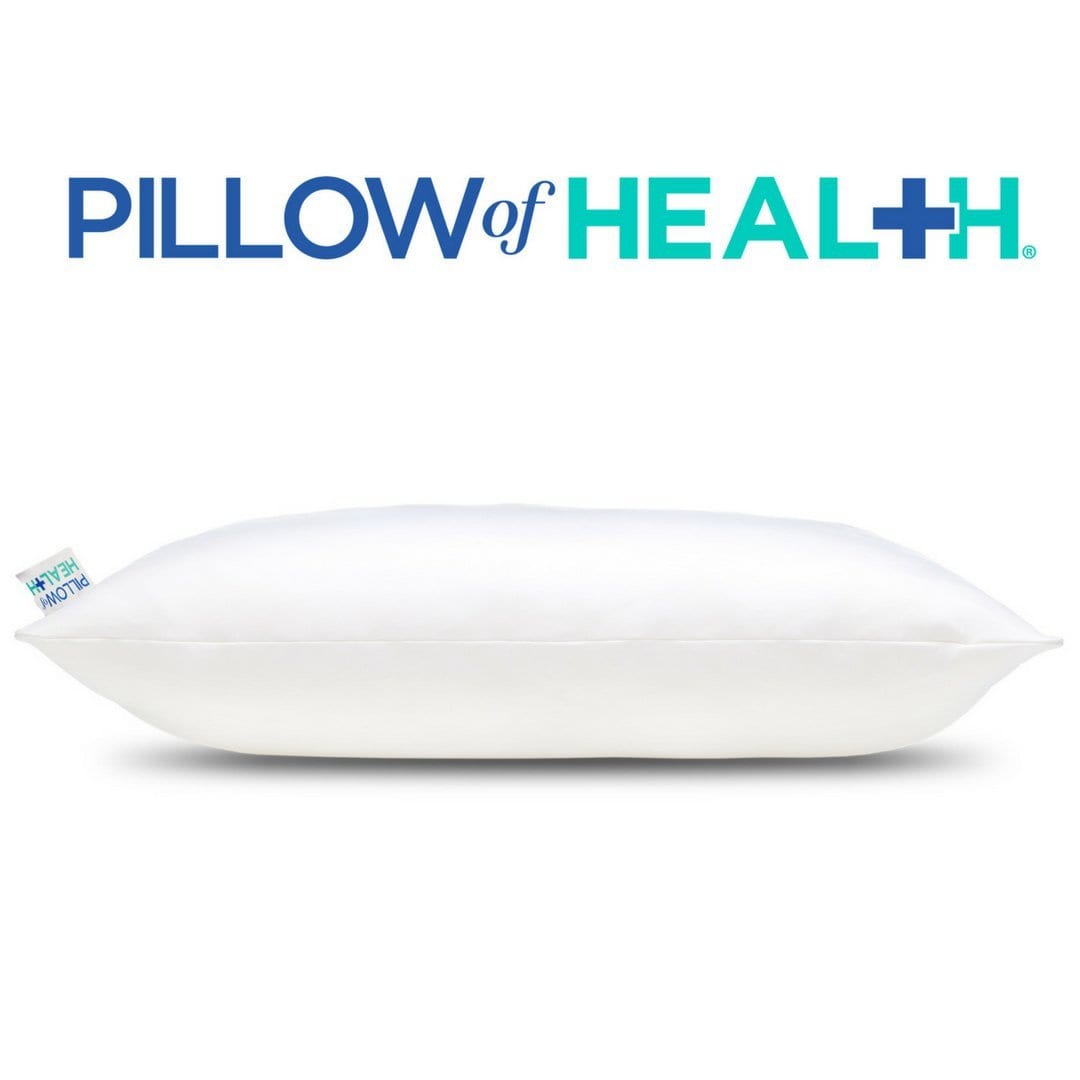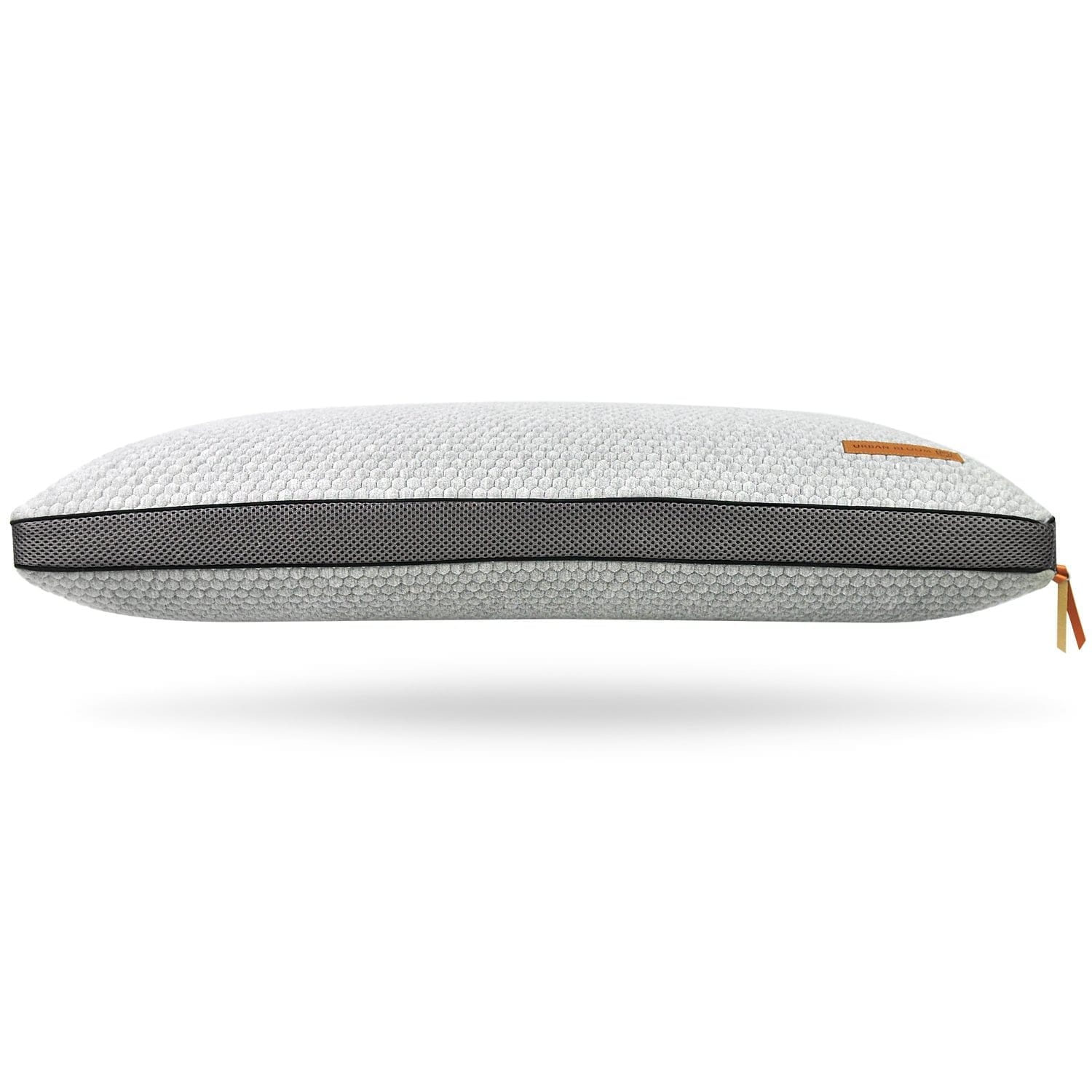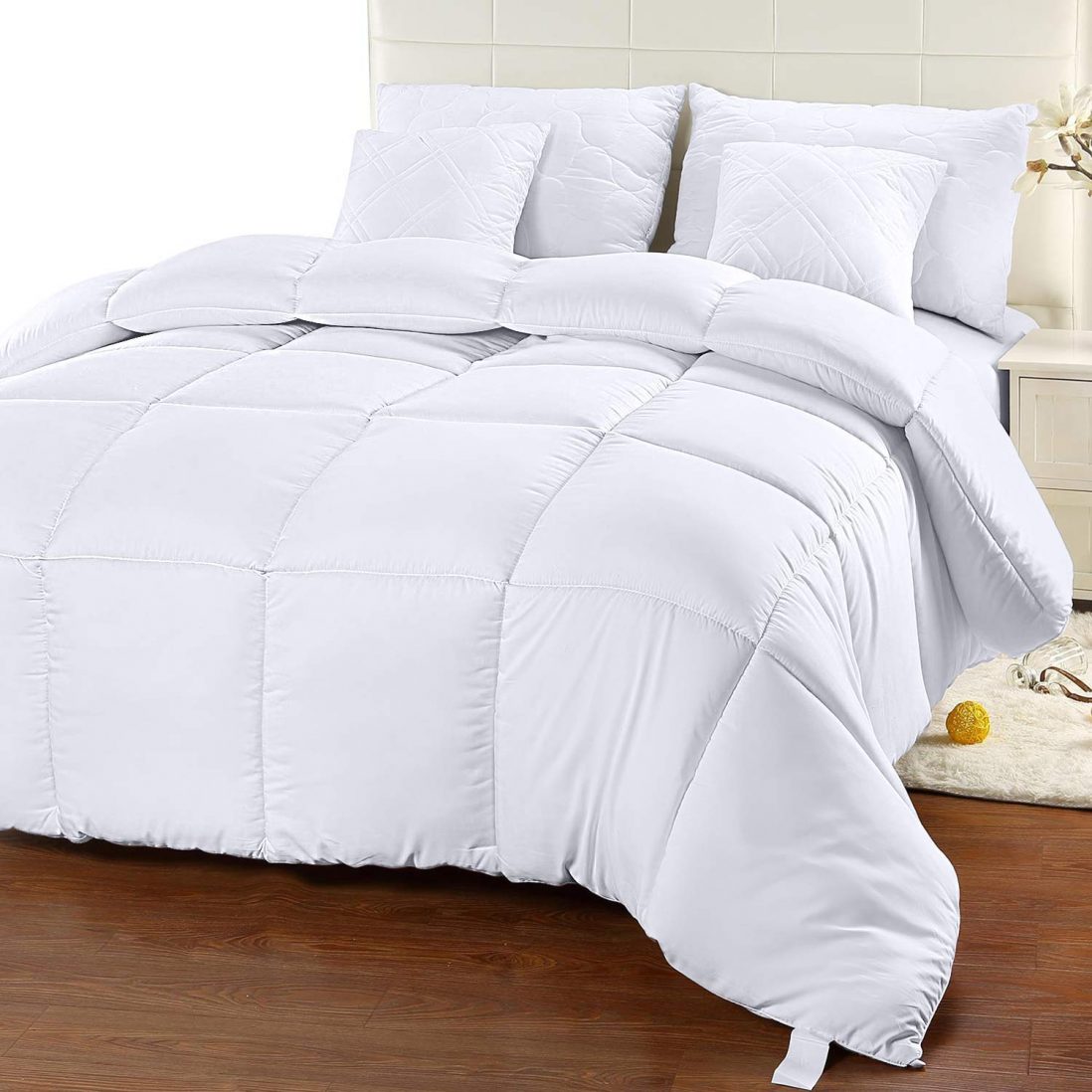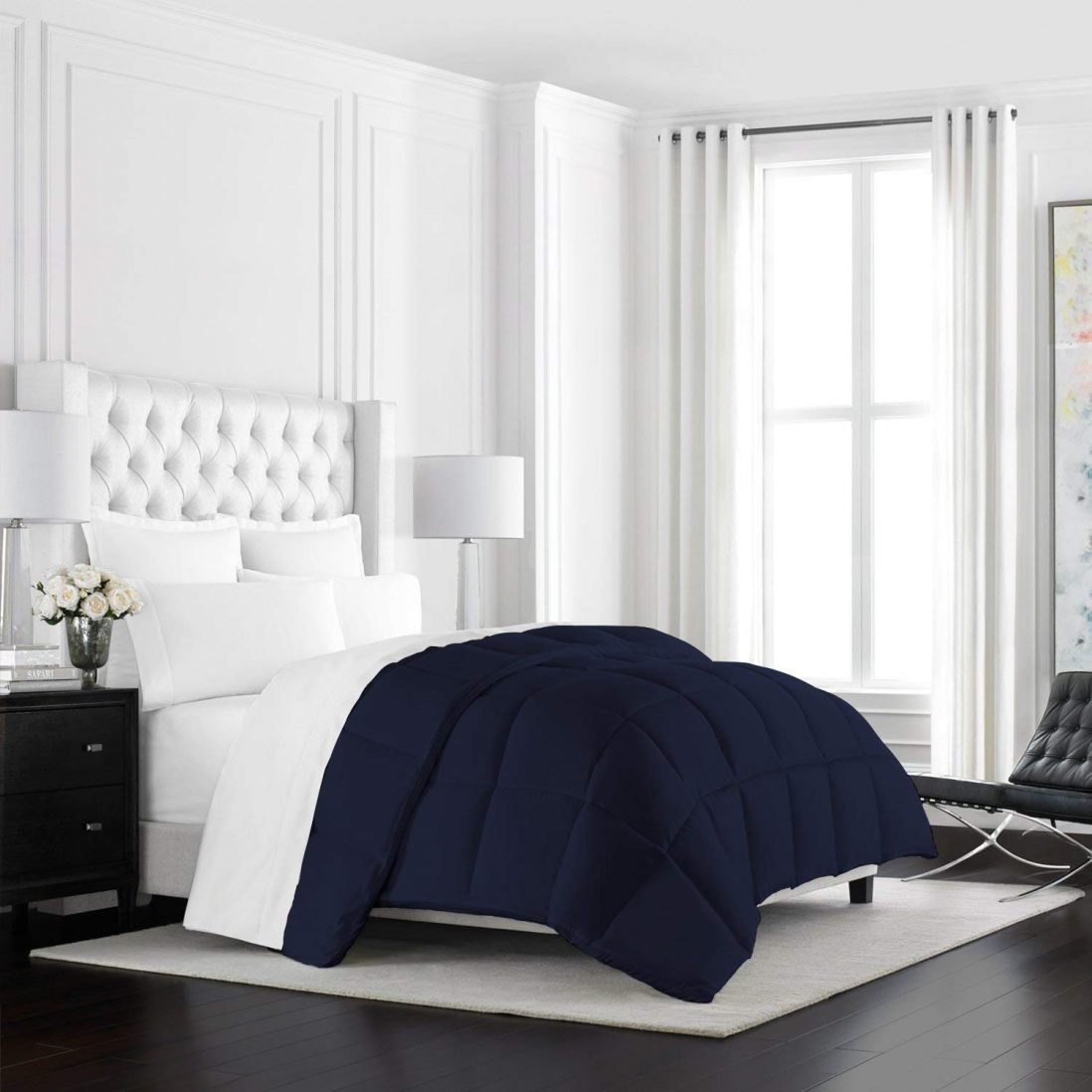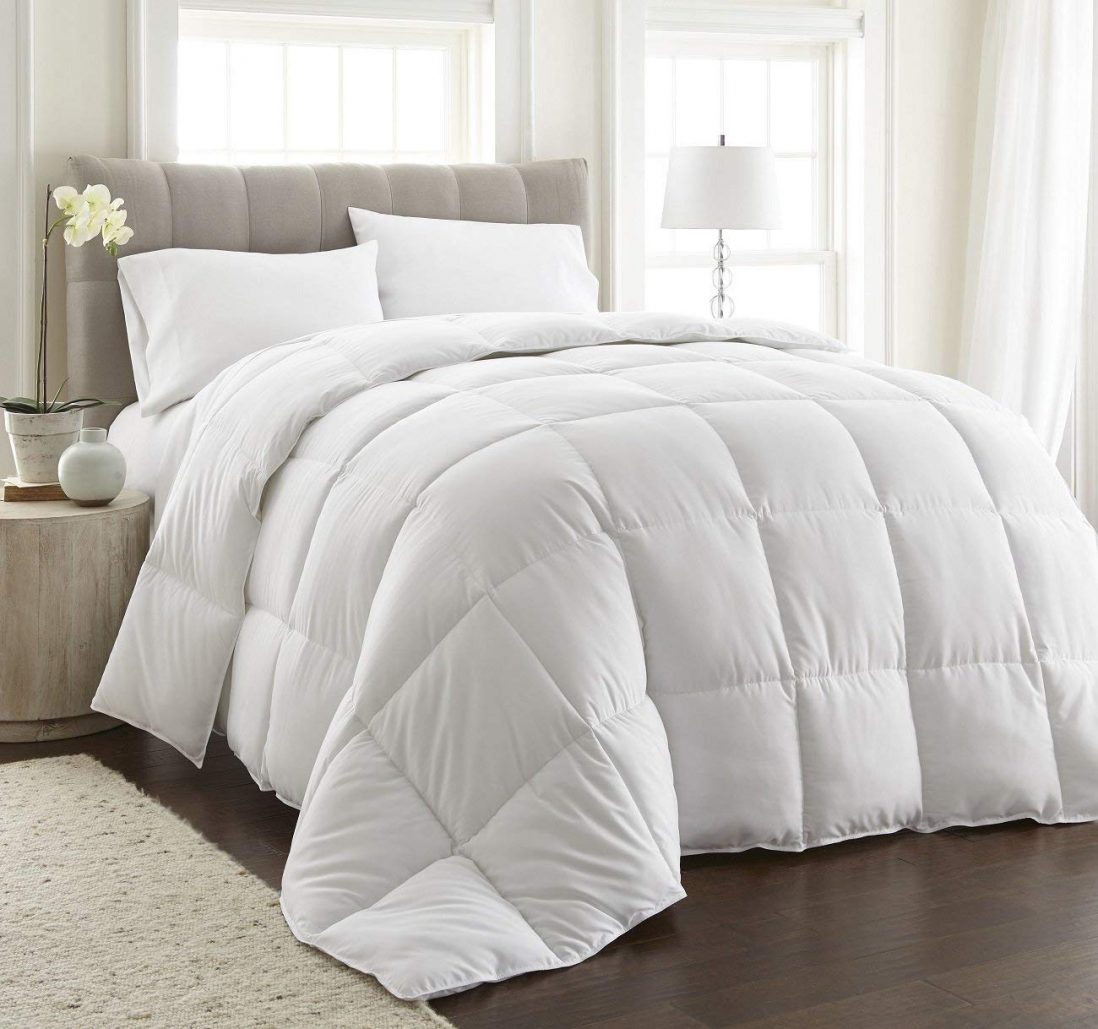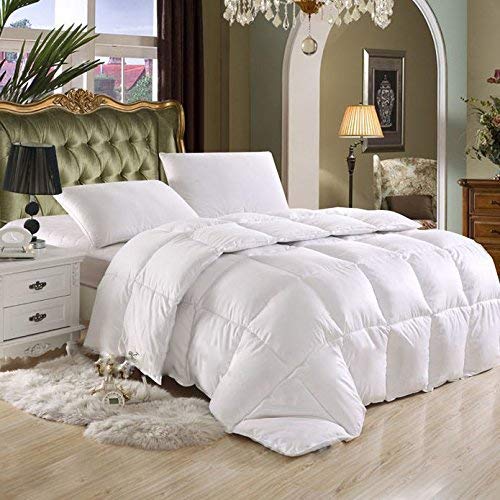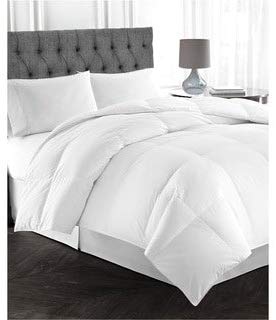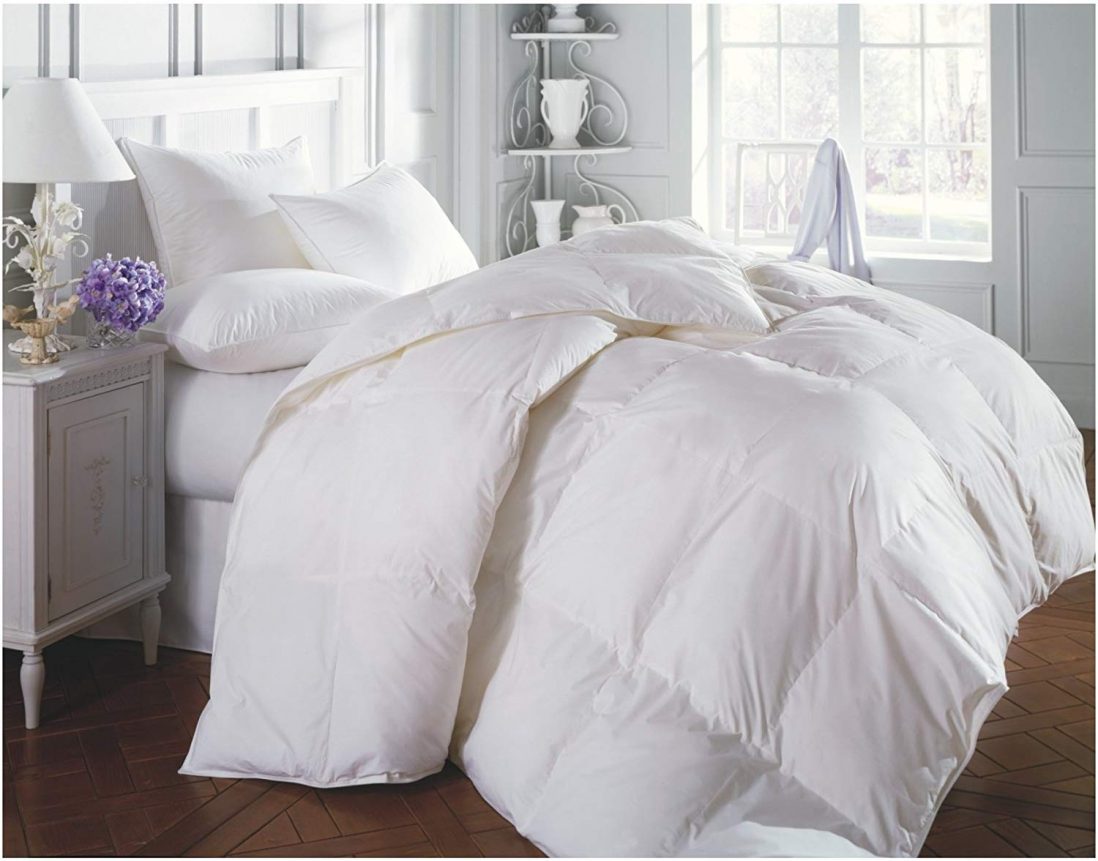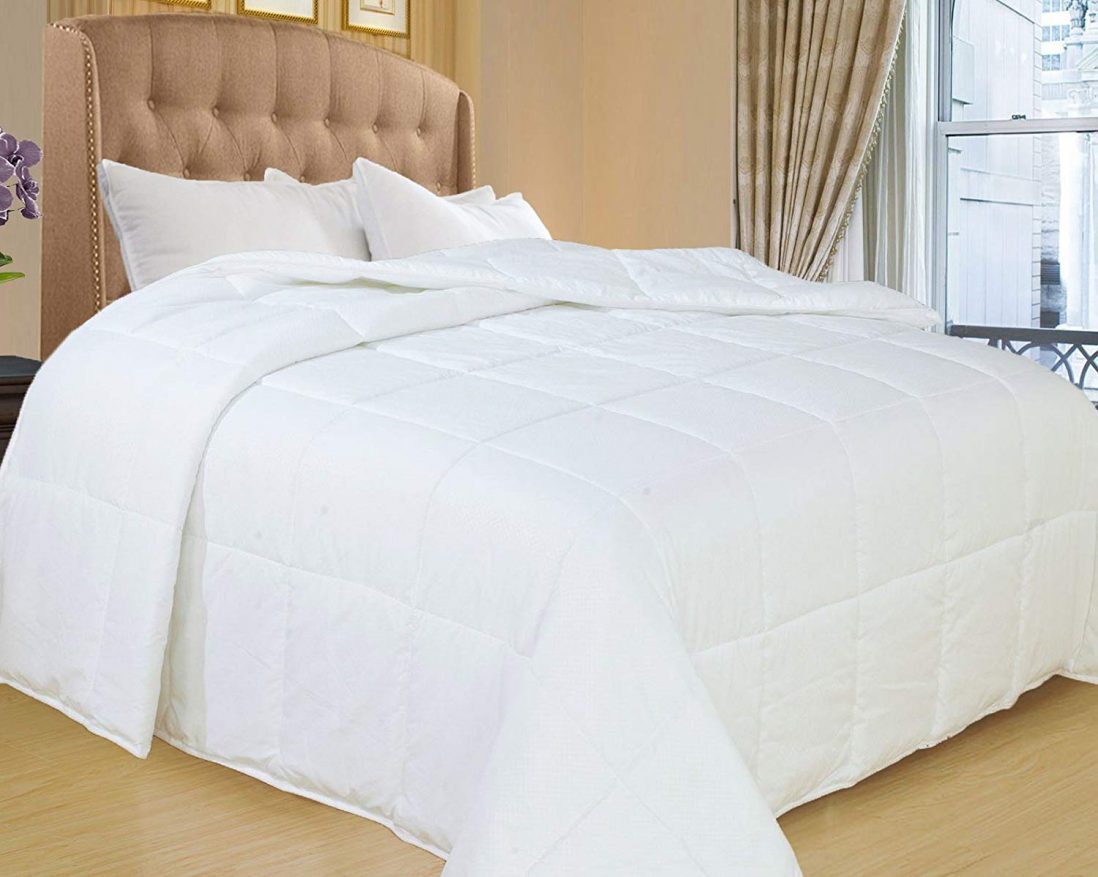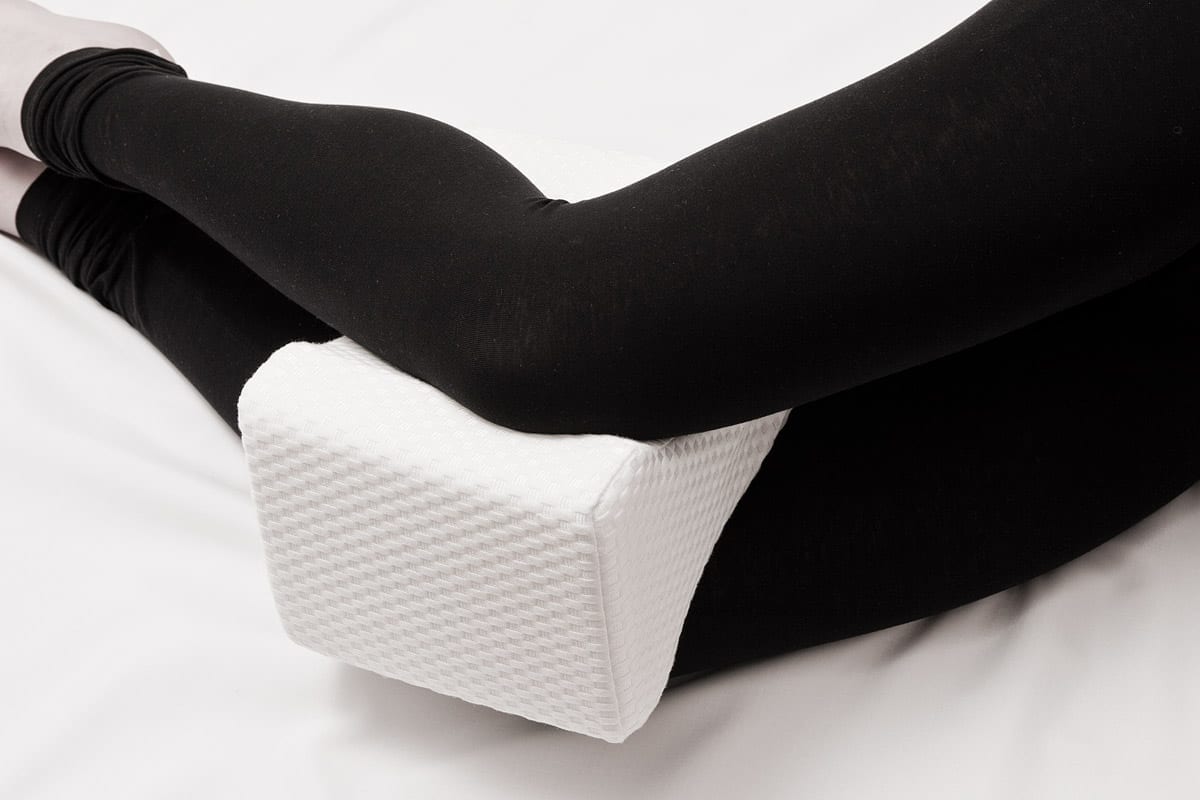In truth, there are lots of benefits to choosing goose and duck down comforters. For example, they have a naturally insulating effect while remaining soft and breathable. Of course, there’s also an obvious drawback; those with allergies can suffer, and the feathers can also feel sharp on the skin. Therefore, we’ve got a guide on the solution today; down alternative comforters.
If you haven’t seen this option before, it offers all the benefits of real down but without the drawbacks. Not only this, they’re generally more affordable too. When choosing a down alternative comforter, there are all sorts of considerations to make, and this includes filling and warmth. For starters, the majority of down-alternative comforters are filled with natural materials like such as cotton or bamboo. This being said, you will also find hypoallergenic synthetic polyester fibers. The higher the fill power, the plusher your comforter will be.
As another consideration, we urge you to think about your climate. If you’re in a warmer climate and tend to overheat, opt for a lightweight comforter. Alternatively, go for a heavier one for colder winter months. With the right decision, you should be able to find an option that works all year round.
In this guide, you’ll find everything you need to make a good decision regarding the best down alternative comforter for your needs. You’ll learn about the most common down alternative fill materials, their benefits, and drawbacks, and buying considerations (including shell material, thread count, and fill power).
With this in mind, let’s start with some brilliant products!
The Best Down Alternative Comforters
- Utopia Bedding: the best overall
- Beckham Luxury Linens: the best heavyweight option
- Chezmoi Collection: the best for all seasons
- LINENSPA: the best lightweight comforter for hot sleepers
- Egyptian Bedding: the best Egyptian cotton option
- Buffy: the best for the environment
- Lavish Comforts: the best for hypoallergenic properties
- Superior: the best for value
- Royal Hotel: the best for a king bed
- Natural Comfort: the best for a twin bed
Table of Contents
The research done on this website is made possible by commissions earned through sales from affiliate links shared within the content. Learn more here.
Down Alternative Comforters Comparison Table
Picture | Product | Key Features | Price |
|---|---|---|---|
- Soft and perfect in all climates | |||
- Hypoallergenic (protect against dust mites, mold, and mildew) | |||
- Box stitching for even coverage | |||
- Microfiber down alternative fill (300gsm fill weight) | |||
- 750+ fill power 600 thread count - 100% Egyptian cotton cover | |||
- Eucalyptus-based shell fabric offers breathability and softness | |||
- No shifting or movement with baffle box construction | |||
- Softness with a microfiber shell | |||
- No shifting with baffle wall box design | |||
- 100 % polyester material |
Down Alternative Comforters Reviews
Utopia Bedding: The Best Overall
With all down alternative comforters considered, this option from Utopia Bedding has long been a favorite. Offering siliconized fiberfill alternative filling, it’s extremely soft and makes every user feel cozy (especially during the winter months!). Another advantage of this particular material is that it’s both hypoallergenic and antimicrobial; you won’t have to worry about bacteria and dust mites. Compared to cotton filler, it should also remain fluffy as it retains shape for longer.
This comforter also has characteristics similar to a duvet. It fits inside a duvet cover, the four corner tabs keep the product in place, and it also changes the appearance of a whole room without a full redecoration. If you haven’t experimented with different duvet covers before, we highly recommend it because it can bring a breath of fresh air to your bedroom.
During manufacturing, Utopia Bedding use piped edges on a box-stitched construction. What does this mean? Well, you get style as well as an even distribution of the filling. Rather than filling all gathering in one place, it should remain consistent over the course of the night. With the ultra-plush feel, it’s difficult not to feel as though you’re floating on a cloud while drifting off to sleep. It’s so comfortable that it has the vacation-like feel as you snuggle in at night.
Luckily, washing is also easy since the comforter can go in the machine on a cold-water cycle. You can dry outside, or on a low heat in the dryer if this isn’t an option.
Beckham Luxury Linens: The Best Heavyweight Down Alternative Comforter
This time, we have a heavyweight down alternative comforter and one that retains heat for the winter nights. This being said, it shouldn’t be too much for the warmer nights too. As we’ve seen before, the filling should remain in place thanks to the box stitching. Even after you wash, it should hold shape, and you stay happy with your investment (rather than looking for a replacement shortly after!).
If you don’t have a cover, don’t worry because the comforter still looks great without. Additionally, the hypoallergenic nature means that you won’t be fighting off mildew, dust mites, and mold yourself. With the brilliant poly-fiber fill, allergens stay away, and you can breathe easy (literally!).
Whenever the comforter needs freshening, put it in the machine with cold water and a gentle wash. After this, you can let it dry naturally or put it in low heat in the tumble dryer. If you aren’t satisfied with your purchase, Beckham Luxury Linens offer a 30-day satisfaction guarantee. Get the product back within this time, and you’ll get a full refund.
Chezmoi Collection: The Best for All Seasons
With this down alternative comforter from Chezmoi, we have a medium warmth option with 220 GSM lofty polyester fill. Therefore, it’s our choice for those looking for a comforter that is ideal for use all year round. Soft to the touch, we believe it will feel cozy both when the sun is beating down, and when the cold frosts up the windows. What’s more, the synthetic poly-fiber is 100% hypoallergenic.
One of our favorite features of this comforter is the double-needle stitching design. Compared to single needle stitching, it offers both durability and strength; the polyester microfiber also can’t escape with this feature. Just like the previous comforter, Chezmoi has opted for piped edges and corner tabs, which make it perfect for using with a duvet cover.
As for washing, the comforter can go into the machine and dryer, which makes everything easier. Especially when your children (or even you) cause spillage on a relaxing Sunday morning, it will be clean again soon after. This is much better than goose down because this generally requires dry-cleaning in order to maintain its fluffiness. Even after several cycles, the comforter should remain fluffy and lofty.
LINENSPA: The Best Lightweight Down Alternative Comforter for Hot Sleepers
As our next recommendation, we’re accommodating those who want a lightweight down alternative comforter thanks to LinenSpa. We’ve spoken about genuine down and feather and how they cause problems with allergies, but it’s sometimes the dust mites and dander they collect that cause the problems. Fortunately, this isn’t an issue with this comforter because of the hypoallergenic microfiber fill.
If you use a duvet cover, you’ll be glad to know there are side and corner loops. With this, you can add decoration to your bedroom without the sliding that tends to occur without duvet loops. LinenSpa actually use a clever design with eight side and corner loops that has a patent pending.
In terms of design, you have a choice of two because the comforter flips from one side to another. Depending on what look you want, this reversible comforter will be ready to help. While some people switch with every wash, others base it on the season. While on this note, it has good airflow, which means it can be used even when summer rolls around. With the medium weight, it feels comfortable, and the box stitching prevents the filling from moving around.
Overall, this comforter is warm, soft, fluffy, and should be durable enough to stay with you for some time to come. As a quilted duvet insert, you can choose between 12 colors and eight sizes, so we’re certain you’ll find what you need. Just in case you needed any more persuading, it even comes with a three-year warranty.
Egyptian Bedding: The Best Egyptian Cotton Option
Egyptian cotton has long been associated with luxury, and Egyptian Bedding certainly conform to this stereotype here. With a good weight and plenty of warmth, their down alternative comforter can be used throughout the year and provides softness night after night. Known as Long Staple Giza cotton, the natural material for the cover shell comes from the Nile River Valley. The appearance is elegant, and with a high 600 thread count, it feels amazing in the bed, so we’re sure you’ll sleep easy with this comforter.
As you know by now, the box stitch design keeps the fill in place; however, Egyptian Bedding go one step further for stability with sewn corner tabs and piping with loops. If you’re worried about feather fills, this option is hypoallergenic. Depending on the size you choose, it can weigh over 70 ounces with a fill power of 750+.
When you order from Amazon, the product will come sealed from the factory, and you’ll also get a warranty (as long as the reseller is legitimate and authorized).
Buffy: The Best for the Environment
We understand that the environment is an important consideration in purchasing decisions these days, so we want to continue this list with the fantastic Buffy down alternative comforter. When it comes to materials, Buffy have gone against the grain with both the shell and the fill. Firstly, the polyester for the fill is spun from recycled plastics. According to Buffy, each comforter actually removes 50 plastic bottles from the environment. With the air-blown fill, the comforter will always feel soft and cozy when lying down. Meanwhile, the shell allows for breathability and softness through the use of a fabric that comes from Eucalyptus.
Although this comforter does provide warmth, it doesn’t keep users too hot, which normally means it can be employed all through the calendar. After this, we love the fact that it’s resistant to mites, microbes, and allergens as a hypoallergenic product.
If you choose Buffy, you’ll get free shipping as well as a refund during the trial period if you don’t get along with the comforter.
Lavish Comforts: The Best for Hypoallergenic Proprties
This down alternative comforter has lots going for it, and this is why it has found popularity - especially for those with allergies. Firstly, the product has corner tabs, offers double brushed microfiber, and is lightweight. With the 100% poly-fiber fill, there’s not even a thought about bacteria, dust mites, mold, and mildew. As long as it is machine dried, they should never be a problem.
Of course, all this is useless if the comforter doesn’t feel nice, but this isn’t a problem with its soft and fluffy nature. Unlike other manufacturers, Lavish Comforts seems to have mastered the balance between warmth and breathability. Their comforter is thick to keep you warm in the winter, and you can snuggle under it without overheating in the summer.
If you thought Egyptian cotton was soft, you haven’t seen anything yet; we believe that the premium double-brushed microfiber, 1800 series, will blow you away. Just in case you aren’t sold on this comforter yet, you also get baffle box design that adds extra quality without any gaps or cold spots.
Superior: The Best Down Alternative Blanket for Value
As a medium weight down alternative comforter, this is another that works all through the calendar. With the fine microfiber shell, it feels soft to the touch while the lofty polyfill down alternative keeps the comforter fluffy for some time. As well as the luxurious feel, this product is noiseless and removes the concern of allergies thanks to the hypoallergenic nature. Even if you have asthma, you can really relax without worrying about repercussions.
If we look at the manufacturing technique for a moment, the double-needle stitching and baffle box construction should keep an even fill distribution even as you move around through the night. The medium weight of this comforter provides a comfortable amount of pressure without being too thick.
Furthermore, we also like the appearance because it will sit well on all sorts of bedding. If you like Superior as a manufacturer, they design their products to be used in a set. This includes blankets, pillows, mattress toppers, mattress protectors, and more. To lose moisture and re-fluff, just put the comforter in the machine and then dry at low heat. After the dryer, it will retain its softness and should remain wrinkle resistant.
Royal Hotel: The Best for a King Bed
When you see the product and consider the name, you think this Royal Hotel down alternative comforter will be expensive. For us, it’s incredibly reasonable for the warmth it provides through the four seasons. As a fluffy and soft comforter, there’s a 300-thread count 100% cotton cover. In case you didn’t know, cotton is a wonderful material for those with allergies because it’s naturally hypoallergenic. Thanks to the easy stretch properties, cotton fabric is generally more durable and stronger than others.
With some comforters, one of the biggest problems is having to constantly readjust the filling. Fortunately, as with most manufacturers in this list, Royal Hotel has considered this problem and decided on a solution in the shape of baffle wall box double stitching. Once the side gusset (one inch) is added, the fill should always remain in place. What’s more, the 750+ fill power allows for maximum loft and complete warmth with minimal cold spots. In terms of weight, it has a medium-weight fill, which means that it can be used all year round.
Natural Comfort: The Best for a Twin Bed
We’ve seen medium weight down alternative comforters, and we’ve seen heavyweight down alternative comforters; now, it’s time for a lightweight comforter suitable for Twin beds. With both the fill and the cover, you don’t need to worry about allergies because it uses 100% polyester fill and shell, which is hypoallergenic. The shell offers a 300 thread count, which should mean a soft surface for the months and years ahead.
Elsewhere, you’ll enjoy the box stitch construction to keep the fill from moving around and the lightweight nature of the comforter, which means that those in warmer climates should be able to use the product without overheating. There’s little more frustrating than waking up sweating in the middle of the night because it feels uncomfortable, and the damp surface makes it hard to get back to sleep; luckily, this comforter is designed to be cool enough for a pleasant sleep.
Although many components of the comforter are imported, it’s put together in the US. Also, it can be washed in the machine, and the appearance makes it ideal for all sorts of bedroom interiors.
What’s a Down Alternative Comforter?
We now have a good idea of what’s available on the market, and you can use our list to research some of the best comforters around, but what actually constitutes a down alternative comforter? Generally speaking, comforters get their fluffiness and softness from geese and duck feathers. There are many advantages of choosing down, and this includes the comfort and warmth it provides. Yet, the biggest problem is the allergies that many people have. Also, we can’t ignore the high price tag that genuine down and feathers command.
Therefore, a down alternative is a material manufacturers have used to create the same effective comforter without the potential for allergy issues. Usually filled with cotton, rayon, or polyester, they may not have the same level of warmth for users, but they still feel amazing, they can be used all year round, and you will also have an easier job cleaning them.
Benefits and Drawbacks of Down Alternative Comforters
Before we go into the buying considerations so that you choose the best down alternative comforter for your needs, we want to assess the benefits and drawbacks of these products. Firstly, what do down alternative comforters have going for them? Why should you choose this product (both in design and filling) over a genuine down comforter?
Lightweight
As our first benefit, some people say that, despite the soft nature of down, it feels heavy when compacted into a comforter. If you already sleep hot or live in a warmer climate, the last thing you want is to have this heavy surface on the bed. Although it won’t be a surprise at this point, down alternative has plenty of lightweight comforters to be used all year long.
Animal-Friendly
Some people are not comfortable buying a down comforter when the manufacturer may use a production process that treats birds poorly. If you’re against the notion of plucking birds for our own comfort, you can have peace of mind with a down alternative comforter.
Easy Maintenance
If you’ve ever owned down bedding in any form, you will know the frustration that comes with cleaning. As a delicate material, most people don’t even attempt cleaning down comforters themselves but pay out for dry cleaning instead. With a down alternative comforter, you will have no such drama. As we saw with most of our examples, it’s normally a case of washing in the machine and then drying on low heat. Even after this, a down alternative comforter will retain all fluffiness, and you can save those pennies for a second time.
Hypoallergenic
As we’ve just discussed, the biggest reason to choose a down alternative is that you don’t need to worry about allergies. Some people have allergies to down, and others to the dust mites and dander that down collects. Either way, these problems are removed with hypoallergenic down alternative filling.
Price
You may know that down comes with a price. Although you will find some options that fall within your budget, the higher quality downs will set you back quite a bit. Alternatively, you can go for this replacement and save your pennies for something more important. Considering the similar experience that down alternative comforters provide, we think it makes for a great investment.
We’ve seen the benefits, so it’s only fair that we look at the drawbacks. For us, there are only really two that you need to consider before spending your hard-earned money.
Durability
Firstly, down comforters have the potential to last for a full generation. On the other hand, down alternative has a much shorter life, and those who go for the cheaper end of the market might be extremely disappointed when a replacement is required within a few years.
Warmth
Secondly, genuine down is better at keeping users warm. If you’re planning to go for a down alternative, we recommend choosing a heavier comforter since this should make up for the lack of warmth.
Most Common Down Alternative Materials
When speaking to people thinking about buying a down alternative comforter, one of the biggest misconceptions we hear is that down alternative is the name of a material. Instead, there are four common materials used in this niche.
Gel Fiber
Not exactly the most common, but comforters with gel fiber can retain heat more effectively thanks to the gel infusion. With this, users can remain warm in even the coldest of climates. Generally speaking, gel fiber comforters are affordable and offer a very similar experience to polyester. However, the biggest problem comes with breathability. If you sleep hot already, this might be an issue.
Primaloft
As the name suggests, this is a material focusing on the loft. With resilience in mind, some say that Primaloft is better than genuine goose down. Compared to a standard down comforter, they say it actually has three times the resilience. As a lightweight, warm, and fluffy synthetic fabric, it’s a clever alternative to down and one that has gained in popularity over the years.
Not only this, but it is resistant to water thanks to special treatment during the manufacturing process. Whenever down gets wet, it loses loft. Primaloft might be more expensive than other alternatives, but it will hold off some water (which might be useful for those with children and where spillages are a regular occurrence in bed!).
Hypodown
Although these comforters tend to sleep hotter, there are advantages to choosing hypodown because it’s more durable. Additionally, these comforters keep dust and mites away even more effectively than other materials. For those hypersensitive to allergens, we recommend this option.
Polyester
Did you know that polyester is a by-product of petroleum? That’s right, it’s spun into narrow fibers, and this allows us to make comforters and other items for the home. As a flexible material, you will find polyester in all sorts of lofts, weights, shapes, and sizes. Compared to other materials, polyester is cheaper, but it doesn’t have the same durability or warmth. This being said, it’s still good enough for most consumers with a balance between durability, softness, and loft.
Other Down Alternative Comforter Fill Materials
We’ve seen the four most common down alternative fill materials, but this isn’t to say that you won’t find other options when scanning the market. With this in mind, here are three more.
Cotton
We saw cotton in one of our examples, and this is because it’s affordable, soft, breathable, and natural material. However, you do need to be careful because some products will have a very little filling and, therefore, won’t hold much warmth for users. However, if you need an extra layer rather than a primary blanket, there’s nothing wrong with having multiple layers in bed.
Wool
As the second alternative to down alternative (stay with us!), we have a warm and heavy material in wool. Despite the reputation it seems to have among consumers, wool can be breathable, so don’t disregard the option without looking at products. With the right comforter, you tend to get a balance between moisture-wicking, heat dissipation, and insulation. It does cost more than some other options, but wool is also hypoallergenic.
In terms of negatives, some users complain about the heavy weight of wool comforters. Additionally, getting the product wrong will mean too much filling and overheating while you sleep.
Silk
From affordable to expensive, we find silk. Your money will go further, and you will benefit from the lightweight nature of your comforter as well as the resistance to dust mites. Furthermore, you will also enjoy the breathability, which allows you to use the comforter in the warmer months. On the other hand, one reason why you might avoid silk is the lack of warmth. Just like cotton, it’s often preferred as an extra layer of bedding.
Things to Consider Before You Buy
With this, it’s time to look at some buying considerations. Once you’ve chosen a fill material, or at least narrowed it down to a couple of options, you then need to keep the following in mind when searching for the best down alternative comforter for your needs.
Size
First, you don’t want a comforter that’s too small or big for your bed. With down alternative comforters, you will find a number of options, including:
- Twin
- Full
- Queen
- King
- California King
Unfortunately, the universal system doesn’t always work when it comes to bedding. Rather than trusting the descriptions from companies, we recommend looking for measurements. For couples who end up arguing over the covers every night, why not choose one a size larger than normal? As long as you consider the extra weight this will bring, you could just save yourself some headaches.
Shell Material
First up, the ‘shell’ describes the fabric on the outside of the comforter. Often, people focus too much on the fill material that they forget the shell, which is actually closer to the body and skin. If possible, you need breathability, softness, and good stitching. There are four main options here:
- Wool - Wool, which comes from sheep, is an expensive option and one not often chosen by the manufacturers of down alternative comforters. If you do find the odd product, know that wool has the benefit of moisture-wicking, which should mean breathability.
- Silk - As we all know, silk has a huge reputation for being one of the smoothest materials around, and this is why many choose it for home bedding products; it feels great against the skin, and it shouldn’t retain heat. Yet, it isn’t used too much with comforters. Why? For two reasons, it’s expensive, and it’s notoriously hard to clean.
- Cotton - This material can be found throughout the home, and this is because it’s cheap, soft, and simple to clean. In most cases, cotton will absorb some heat and moisture. However, cotton does tend to absorb moisture and may heat up more than some other fabrics; however, its breathability can vary based on the thickness.
- Blends/Synthetics - We saw synthetics with regards to fill, and they’re also used for the shell material. Breathable, soft, and stretchable, the most common blend is with cotton since this adds the much-needed softness.
Fill Power
We know that confusion fills this area of comforters, and it can lead to some people buying the wrong product. Don’t worry, it’s very simple and refers to the amount of space taken by one ounce of the fill material. Therefore, warmth comes from the higher fill power. Since this is a term used mostly with genuine down, it’s not always a stat available with down alternative comforters, but some manufacturers do provide it for easy comparison. Here’s a general breakdown:
- Over 800 - With insulation and loft in abundance, products with fill power above 800 are normally designed for winter and will probably cause overheating if you aren’t also using air conditioning in the summer.
- Between 600 and 799 - With this option, we have comforters that work all year round. While those who sleep cool will need something closer to 799, those who sleep hot can go near to 600.
- Between 400 and 599 - As the third category down, it might not have the warmth for winter months and therefore isn’t quite suitable for the full calendar. This being said, you will be comfortable enough and still warm when layering multiple blankets.
- Below 400 - At the other end of the scale, we have a down alternative comforter that doesn’t provide too much heat. Instead, they’re made for summer and can be layered with other blankets for the colder months.
Thread Count
Just like fill power, thread count is another area that causes confusion. Essentially, it’s the tightness of the weave in the outer cover fabric to hold the fill together. With a high thread count, there’s a tight weave, and it should hold for longer (and no holes should occur from fill poking through). Depending on the material you choose from, you will find thread counts of anywhere between 100 and 600. When a higher thread count is used, it leads to a durable and soft final product. Here’s a breakdown of the options:
- 100 and 200 - Common choice that provides a standard experience.
- 300 - High-quality with breathability and softness.
- 400, 500, and 600 - Luxurious experience.
Stitching
Stitching determines how much of the filling can move inside the shell. In our experience, the three main types of stitching dominate the market with down alternative comforters:
- Baffle Box - As we saw with our examples of the best down alternative comforters, this is a popular choice with manufacturers these days. To connect the shell, extra fabric is recruited, and this means that each compartment is deeper when sewn-through. With baffle box design, you get plenty of filling, thickness, and warmth. However, to keep it this way, it will need some fluffing.
- Gusseted - The edges of the exterior are sewn together to connect the top and the bottom of the shell. With this design, manufacturers can add extra filling with little hassle. Not only do users need to fluff these comforters constantly, it’s also prone to clumping and uneven distribution.
- Sewn-Through - This time, the top and bottom of the shell are connected with stitching right through them. Rather than just around the edges, the stitching goes through the whole comforter and creates compartments that hold sections of filling. Since each compartment is self-contained, you shouldn’t need to fluff the comforter, and you should have even distribution throughout the night. Unfortunately, the downside is a lack of loft and warmth.
Level of Warmth
Where do you live, and how is the climate? While some people will need to stay cool through the night, others will be looking for warmth throughout most of the year. Alternatively, you might also buy a heavier down alternative comforter in hopes of reducing the thermostat and saving some money. During the winter, look for a medium or heavyweight comforter. Otherwise, you’ll find yourself needing a second blanket. Also, consider your own comfort when searching for warmth. Though a thicker down alternative comforter will certainly hold the heat between the sheets, it can also make some users feel a little trapped and claustrophobic.
Pattern/Design
With one look online, you’ll quickly realize that down alternative comforters come in all sorts of patterns and designs. While duvets are white and the design comes from the cover, comforters have their own design, and we suggest looking around to find one that matches the decor of your bedroom.
Comforter or Duvet Insert
As an important side note, the words’ comforter’ and ‘duvet’ can’t be used interchangeably, and we’ve been careful not to make this mistake today. When you buy a duvet insert, you need to buy a duvet cover separately. Meanwhile, a comforter comes with a cover already built-in. Think about which one you need and remember that the removable cover on a duvet makes cleaning easier. If you choose a comforter, make sure it can go in the machine to save the hassle.
Environment
If you’re conscious of the environment and actively make purchasing decisions with this in mind, some companies will only use natural and safe materials. With this, you don’t have to worry about chemicals in your down alternative comforter, and you can be happy that it was manufactured with our beautiful planet in mind. For example, some manufacturers will actually recycle water bottle fibers for an organic comforter.
Budget
With so many different products and manufacturers on the market, there’s really no need to spend an amount with which you’re uncomfortable these days. In addition to the comforter, remember that you also may need to buy a duvet cover. Elsewhere, some pay out for a flat sheet because this provides an additional layer between the comforter and the user. Depending on size and quality, you can spend between $25 and $200 on this alone. Therefore, consider all the purchases you need to make and how much you want to spend in total.
How to Wash Down Alternative Comforter
As we near the end of this extensive guide (we hope you’ve found lots of useful information so far!), we wanted to touch on the subject of care and maintenance. Since comforters can sit within a cover, it’s normally this outer layer that gathers the most dust and dirt. Therefore, it can be thrown in the wash whenever required. However, we noted previously that many down alternative comforters can actually be washed.
Washing
According to most manufacturers, only those comforters that have been extensively dirtied or stained need to be washed more than once a year. With the synthetic materials, washing is simple, and you don’t need to worry about clumping (unlike with genuine down!).
Either after soiling or when the comforter needs freshening up, we recommend a front-loading machine if possible because the rotation in a top-loading machine can cause damage to the stitching. What’s more, water will sit in the synthetic material, and this extra weight can actually cause problems for the motor in top-loading machines. Since we’re only looking at one cleaning a year, those without a front-loading machine might be happier to visit a laundromat.
In terms of products, only a little detergent is required. With too much, rinsing becomes difficult. From here, choose a normal wash cycle. If you want to ensure that all of the suds have been washed out of the comforter, put it through a second rinse cycle.
Drying
When washing a comforter, one of the biggest problems is the amount of water it absorbs. In our experience, air drying is a good way to get all of the water out. Otherwise, use the dryer at a low heat setting. To prevent the material from clumping, another handy tip is to take the comforter from the machine after each cycle and fluff it up.
Once done, make sure the comforter is completely dry. When left damp, this increases the risk of mildew. Similarly, don’t dry your comforter on the line because you face the same risk.
FAQs
At this point, all that’s left is to answer some common questions people have when buying down alternative comforters.
How do I fluff up a down alternative comforter?
Throughout this guide, we’ve been talking about fluffing up a down alternative comforter, but what do we actually mean by this? For us, one of the most effective techniques is a low heat in the tumble dryer. With a tennis ball or two to prevent balling up, it should come out nice and fluffy.
For those without a dryer, the idea is to create gaps in the fibers, and this can be achieved by shaking the comforter. With the comforter laid out, grab one corner and pull it up and down with some force. Soon enough, it will come back to life.
Is a duvet cover necessary for a down alternative comforter?
Many down comforters are not designed to be washed, which is why a duvet cover is recommended. With a down alternative, you have more freedom because the comforter is washable. Ultimately, it’s up to you. Why not try without and then make a decision from there?
Are down alternative comforters durable?
Down comforters are known to last at least 10 years; some are able to last for 15 years and even longer. Of course, the more care you take in looking after the comforter, the longer it will last. On the flip side, down alternative comforters can’t compete for durability but can still last a handful of years.
Which is better between down vs. down alternative?
Down has a higher fill power, which means that it takes less stuffing to keep you warm. What’s more, down tends to be more breathable. Yet, we have assessed some benefits of choosing a down alternative comforter today (including the hypoallergenic nature of the material!).
What considerations are important when buying a down alternative comforter?
For us, we like to focus on two main considerations; size and warmth level. Since a comforter is normally chosen for warmth, you need to select one that suits the climate you live in. In other words, colder climates will need a thicker comforter. For those who sleep with a partner, we recommend choosing a larger size (or even buying a second comforter). Especially for couples who end up battling for covers during the night, this extra size will allow for plenty of comforter for you both. Hopefully, it lasts for many years, and neither has to worry about waking up with cold feet.
Will down alternative retain the same warmth as genuine down?
With a genuine down, there’s no arguing that you will be warmer. The down from beneath a goose’s feathers comes in very dense clumps that ducks and geese normally use to stay protected against harsh winds during the colder months. Therefore, you can be confident in remaining warm under this material.
With down alternative comforters, the focus for manufacturers is more on creating a similar feel and experience. Unfortunately, it’s difficult to reproduce the heat retention found with genuine down. If we take polyester as an example, it might be possible to put the synthetic material in the same formation, but it just won’t retain heat in the same way.
However, if you’re currently weighing up the pros and cons of both, don’t forget that there are benefits to choosing down alternative too. For one thing, the fact that synthetic materials are used makes it many times easier to wash and dry your comforter. With this, it can be freshened whenever required, and this leads nicely to the next common question.
Why should I choose a down alternative comforter?
With comforters in general, they’re a great way to keep warm through the night. As for a down alternative, it’s a cheaper material than genuine down. Since it’s a synthetic material, it can also hold onto its shape for longer, and your investment goes further.
While down comforters might be fluffier, even hypoallergenic shell covers can’t prevent allergic reactions. Here, we touch on an important point because down alternatives are normally 100% hypoallergenic. With some of the best down alternative comforters using silk, bamboo, and other natural fibers, you steer clear of reactions while also enjoying the easier cleaning and maintenance.
Is it possible to clean down alternative comforters?
Yes, and we refer you to our earlier section, all about washing and drying down alternative comforters. Even if only on the lowest settings, most products can go in the machine. If you want to prevent accidents, always read the instructions on your product. If you see a small tear in your comforter, don’t use the machine because this will make it worse. Instead, bring it to a dry cleaner, letting them know about the damaged area.
How do companies ship down alternative comforters?
Comforters are usually shipped in a clear, rectangular, plastic zipper bag. If you keep hold of this waterproof bag, you have a transporter if ever you need to take the comforter somewhere. Of course, it is only a plastic bag, so be careful with storage (it won’t take much to rip or tear!).
Conclusion
Thank you for reading our guide on down alternative comforters, we hope you’re able to find a comforter that suits you and your loved ones in the time ahead. Not only are down alternative comforters ethically sound, they’re hypoallergenic, which means that those with allergies can rest easy. They balance warmth, softness, and fluffiness, and most even go in the machine for simple maintenance. As long as you read product descriptions and check the measurements, you will avoid disappointment.
When looking for the best down alternative comforter for your needs, remember the product and personal buying considerations we provided earlier. Also, go back to the very first chapter, where we looked at some brilliant examples. Good luck in your search, we hope you find a comforter that keeps you warm and cozy in the coming months and years!
